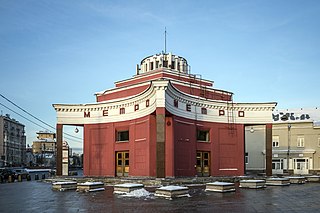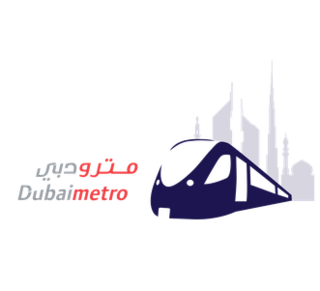
The Paris Métro, operated by the Régie autonome des transports parisiens (RATP), is a rapid transit system in the Paris metropolitan area, France. A symbol of the city, it is known for its density within the capital's territorial limits, uniform architecture and historical entrances influenced by Art Nouveau. The system is 245.6 kilometres (152.6 mi) long, mostly underground. It has 320 stations of which 61 have transfers between lines. There are 16 lines, numbered 1 to 14, with two lines, Line 3bis and Line 7bis, named because they used to be part of Line 3 and Line 7, respectively. Line 1, Line 4 and Line 14 are automated. Lines are identified on maps by number and colour, with the direction of travel indicated by the terminus.

The Moscow Metro is a metro system serving the Russian capital of Moscow as well as the neighbouring cities of Krasnogorsk, Reutov, Lyubertsy and Kotelniki in Moscow Oblast. Opened in 1935 with one 11-kilometre (6.8 mi) line and 13 stations, it was the first underground railway system in the Soviet Union.

The Washington Metro, often abbreviated as the Metro and formally the Metrorail, is a rapid transit system serving the Washington metropolitan area of the United States. It is administered by the Washington Metropolitan Area Transit Authority (WMATA), which also operates the Metrobus service under the Metro name. Opened in 1976, the network now includes six lines, 98 stations, and 129 miles (208 km) of route.

A metro station or subway station is a train station for a rapid transit system, which as a whole is usually called a "metro" or "subway". A station provides a means for passengers to purchase tickets, board trains, and evacuate the system in the case of an emergency. In the United Kingdom, they are known as underground stations, most commonly used in reference to the London Underground.

The Tokyo Metro is a major rapid transit system in Tokyo, Japan, operated by the Tokyo Metro Co. With an average daily ridership of 6.52 million passengers, the Tokyo Metro is the larger of the two subway operators in the city; the other being the Toei Subway, with 2.85 million average daily rides.

The Mumbai Metro is a rapid transit (MRT) system serving the city of Mumbai and the wider Mumbai Metropolitan Region in Maharashtra, India.

The Dubai Metro is a rapid transit rail network in the city of Dubai, United Arab Emirates. It is currently operated by a consortium of the French company Keolis and Japanese company MHI, as Keolis-MHI.The Dubai Metro is an advanced rapid transit system in Dubai, UAE, known for its efficiency, cleanliness, and extensive coverage of the city. The metro system consists of two main lines: the Red Line and the Green Line, with more lines planned for future expansion.

The Kolkata Metro is a rapid transit system serving the city of Kolkata and the Kolkata Metropolitan Region in West Bengal, India. Opening in 1984, it was the first operational rapid transit system in India, besides being the second busiest and fourth-longest metro network in India. As of March 2024, it has four operational lines: the 32.13 km (19.96 mi) Line 1 from Dakshineswar to Kavi Subhash, 14.1 km (8.8 mi) Line 2 from Salt Lake Sector V to Howrah Maidan, 7.75 km (4.82 mi) Line 3 from Joka to Majerhat and 5.4 km (3.4 mi) Line 6 from Kavi Subhash to Hemanta Mukherjee for a total of 59.38 km (36.90 mi). Two other lines are in various phases of construction and planning. The system has a mix of underground, at-grade, and elevated stations using both broad-gauge and standard-gauge tracks. Trains operate between 06:55 and 22:30 IST and the fares range from ₹5 to ₹50.

Namma Metro, also known as Bengaluru Metro, is a rapid transit system serving the city of Bengaluru, the capital city of the state of Karnataka, India. It is the second-longest operational metro network in India with an operational length of 73.75 kilometers, just behind Delhi Metro. Upon its inauguration in 2011, it became the first underground metro system in South India. Namma Metro has a mix of underground, at grade, and elevated stations. Out of the 66 operational metro stations of Namma Metro as of October 2023, there are 57 elevated stations, eight underground stations and one at-grade station. The system runs on standard-gauge tracks.

The Yellow Line is a metro rail line of the Delhi Metro, a rapid transit system in Delhi, India. It consists of 37 stations from Samaypur Badli in Delhi to Millennium City Centre in the neighbouring city of Gurgaon in Haryana. The 49.02 kilometers (30.46 mi) line is mostly underground and laid under one of the most congested parts of Delhi. The Yellow Line is the second line of Delhi Metro to become operational after the Red Line.

The Chennai Metro is a rapid transit system serving the city of Chennai, India. Operated by Chennai Metro Rail Limited (CMRL) – a joint venture between the Government of India and the Government of Tamil Nadu, the network consists of two lines and spans 54.1 km (33.6 mi). The system uses standard gauge and has 41 underground and elevated stations.

The Montreal Metro is a rubber-tired underground rapid transit system serving Greater Montreal, Quebec, Canada. The metro, operated by the Société de transport de Montréal (STM), was inaugurated on October 14, 1966, during the tenure of Mayor Jean Drapeau.

The Hyderabad Metro is a rapid transit system, serving the city of Hyderabad, Telangana, India. It is the third longest operational metro network in India after Delhi Metro and Namma Metro (Bengaluru), and the lines are arranged in a secant model. It is funded by a public–private partnership (PPP), with the state government holding a minority equity stake. Hyderabad Metro is the world's largest elevated Metro Rail system based on DBFOT basis. A special purpose vehicle company, L&T Metro Rail Hyderabad Ltd (L&TMRHL), was established by the construction company Larsen & Toubro to develop the Hyderabad metro rail project.

Rapid transit or mass rapid transit (MRT), commonly referred to as metro, is a type of high-capacity public transport that is generally built in urban areas. A grade separated rapid transit line below ground surface through a tunnel can be regionally called a subway, tube, or underground. They are sometimes grade-separated on elevated railways, in which case some are referred to as el trains – short for "elevated" – or skytrains. Rapid transit systems are railways, usually electric, that unlike buses or trams operate on an exclusive right-of-way, which cannot be accessed by pedestrians or other vehicles.

Urban rail transit in India plays an important role in intracity transportation in the major cities which are highly populated. It consists of rapid transit, suburban rail, monorail, and tram systems.

The Delhi Metro is a rapid transit system which serves Delhi and its adjoining satellite cities of Ghaziabad, Faridabad, Gurugram, Noida and Bahadurgarh in the National Capital Region of India. The system consists of 12 colour-coded lines serving 288 stations, with a total length of 350.42 kilometres (217.74 mi). It is India's largest and busiest metro rail system and the second-oldest, after the Kolkata Metro. The metro has a mix of underground, at-grade, and elevated stations using broad-gauge and standard-gauge tracks. The metro makes over 4,300 trips daily.

The Sydney Metro is a fully automated rapid transit rail system in Sydney, New South Wales, Australia. It currently consists of the Metro North West & Bankstown Line, running between Tallawong and Sydenham and consisting of 21 stations on 52 km (32 mi) of twin tracks, mostly underground. The first stage of the line opened on 26 May 2019, running between Tallawong and Chatswood. This line was extended from Chatswood to Sydenham on 19 August 2024 as part of the first stage of the City & Southwest project. The second stage of the project will then further extend this line to Bankstown as part of a partial conversion of the existing Bankstown Line with a scheduled completion in 2025.

The Magenta Line is a metro rail line of the Delhi Metro, a rapid transit system in Delhi, India and the first driverless metro in India.The line is laid on most of the parts of South Delhi and is mostly underground.The total length of the line is 37.46 kilometers (23.28 mi) and it consists of 25 metro stations from Janakpuri West to Botanical Garden, out of which 10 are elevated and the rest are underground. Unlike the Airport Metro Express, this line directly serves Terminal 1 of the Indira Gandhi International Airport.

















